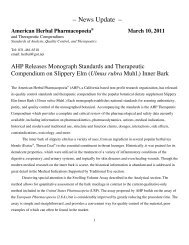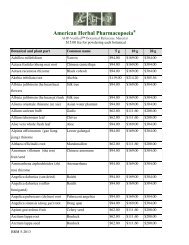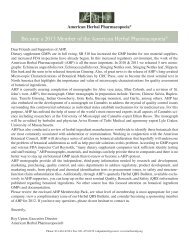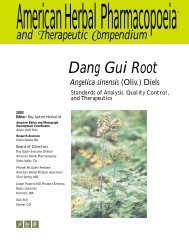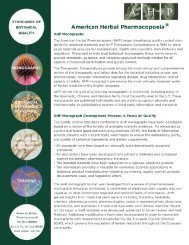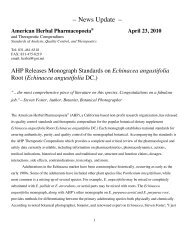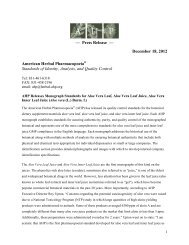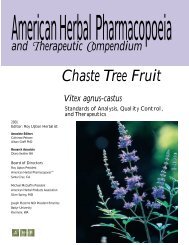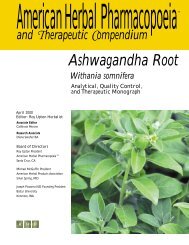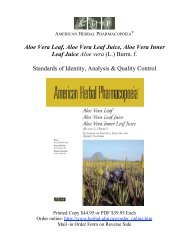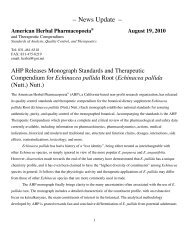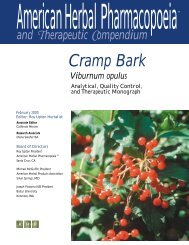alerian oot - American Herbal Pharmacopoeia
alerian oot - American Herbal Pharmacopoeia
alerian oot - American Herbal Pharmacopoeia
Create successful ePaper yourself
Turn your PDF publications into a flip-book with our unique Google optimized e-Paper software.
N OMENCLATURE<br />
Botanical Nomenclature<br />
V<strong>alerian</strong>a officinalis L., s.l.<br />
Botanical Family<br />
V<strong>alerian</strong>aceae<br />
Definition<br />
V<strong>alerian</strong> consists of the fragments or whole fresh or dried rhizomes, r<strong>oot</strong>s, and stolons<br />
of V<strong>alerian</strong>a officinalis L., s.l. The whole botanical contains not less than 0.5% (V/w)<br />
essential oil as determined on a dry weight basis. Powdered material contains not less<br />
than 0.3% (V/w) essential oil as determined on a dry weight basis.<br />
Common Names<br />
United States: V<strong>alerian</strong><br />
France: V<strong>alerian</strong>e<br />
Germany: Baldrian<br />
Italy: Amantilla<br />
United Kingdom: V<strong>alerian</strong><br />
H ISTORY<br />
The name v<strong>alerian</strong> is said to be derived either from Valerius, who was reported to<br />
have first utilized its medicinal properties, or from the Latin term valere, meaning<br />
health or well-being (Grieve 1976). It has been used medicinally for at least 2000<br />
years. Dioscorides (ca. AD 40-80) wrote of several species of v<strong>alerian</strong> (phu), and<br />
Galen (ca. AD 131-208) reported on its sedative effects (Pickering 1879). The name<br />
v<strong>alerian</strong> was first used around the 9th and 10th centuries and was an entry in the<br />
domestic books of home remedies as early as the 11th century. The names v<strong>alerian</strong>,<br />
amantilla, and fu were all used synonymously in the Alphita, a medieval vocabulary<br />
of the schools of Salernum (Flückiger and Hanbury 1879). It was first used as a treatment<br />
for epilepsy in the late 16th century reportedly by Fabius Columna, who related<br />
a personal cure, but subsequently was also reported to have relapsed. Fifty years<br />
later, additional reports of its effectiveness in three cases of epilepsy were reported by<br />
Dominicus Panarolus. Numerous reports by a wide variety of writers followed, and<br />
v<strong>alerian</strong> subsequently became routinely used for the treatment of various nervous disorders<br />
(Benigni and others 1971; Hobbs 1989). Respected <strong>American</strong> medical botanist<br />
William Woodville reported that various European authorities ascribed antispasmodic,<br />
anthelmintic, diuretic, diaphoretic, and emmenagogue actions to v<strong>alerian</strong><br />
and related its usefulness for hysteria. However, Woodville himself did not consider<br />
it to be as effectual as proclaimed by other writers, an opinion reportedly supported<br />
by the Edinburgh Dispensary (Woodville 1810).<br />
V<strong>alerian</strong> was widely used by Eclectic physicians. John King, in his highly<br />
acclaimed <strong>American</strong> Dispensatory, cited v<strong>alerian</strong> as being an aromatic stimulant and<br />
reported some unique indications, including its use for rheumatism, low grade fevers,<br />
and as an aphrodisiac, as well as its use in hysteria (King 1866). John Finley<br />
Ellingwood in Systematic Treatise on Materia Medica and Therapeutics considered<br />
v<strong>alerian</strong> to be a nervine and sedative for the treatment of hysteria, epilepsy, and<br />
menopausal nervous anxiety (Ellingwood and Lloyd 1900). John Milton Scudder in<br />
Specific Medications (Scudder 1903) cites v<strong>alerian</strong> as having activity as a cerebral<br />
stimulant, analgesic, and sedative useful in nervous irritability, specifically when the<br />
condition is a result of “enfeebled cerebral circulation”.<br />
V<strong>alerian</strong> was included in many editions of the United States Dispensatory which<br />
reported on its effect on the nervous system and its ability to produce drowsiness and<br />
sleep (Wood and Bache 1849). It was also listed in official compendia throughout the<br />
world, including the British Pharmacopœia in 1867 (British Pharmacopœia 1867),<br />
Photograph © 1999 Martin Wall Photography, Pleasant Garden,<br />
NC. Location Gaia Herbs, Brevard, NC<br />
<strong>American</strong> <strong>Herbal</strong> <strong>Pharmacopoeia</strong> • V<strong>alerian</strong> R<strong>oot</strong> • April 1999 Page 1



